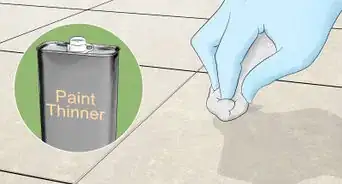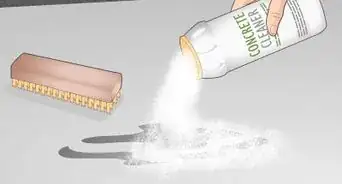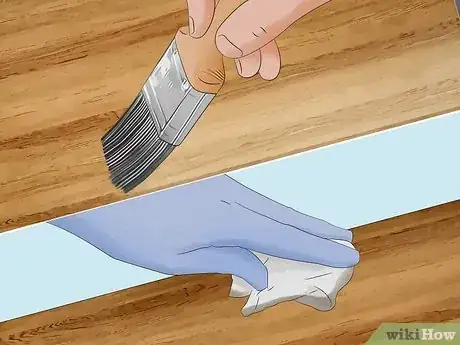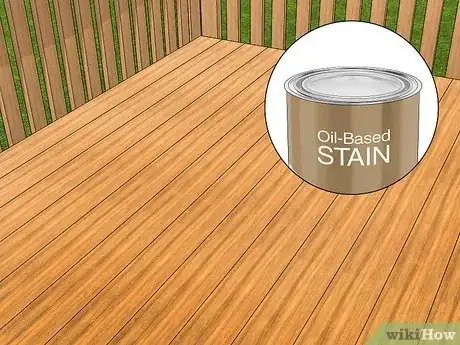This article was co-authored by Eric Shipe and by wikiHow staff writer, Eric McClure. Eric Shipe is a Kitchen and Bath Designer and the Owner of Bath + Kitchen based in Washington DC. Eric and his team specialize in cabinetry, design, and remodels. They serve homeowners, interior designers, architects, and contractors with a refined process, creative ideas, 4K photo-realistic renderings, and 360 Panoramic views. Bath + Kitchen was featured in Best of Houzz 2017-2020. Eric holds a BA in Economics and Business Administration from Ursinus College.
There are 7 references cited in this article, which can be found at the bottom of the page.
This article has been viewed 3,552 times.
Whether you’re breathing new life into an old wooden deck or revamping your kitchen cabinets with a new look, it’s important to choose the right stain. But if you’re perusing the shelves at your local hardware store, you’re likely to notice two different varieties: oil- and water-based stains. But what are the big differences? When should you choose one over the other? In this article, we’ll help answer these questions and more so that you can pick the ideal stain for the job.
Things You Should Know
- Water-based stains preserve the look, feel, and color of wood, but they’re harder to apply and maintain.
- Oil-based stains hold up better in crazy weather, they’re more durable, and they’re easier to work with.
- Regardless of the stain you choose, sand the wood before applying it and seal the wood when you’re done to protect your work.
Steps
Advantages of Water-Based Stain
-
1Maintains the original texture and look of wood Water-based stains don’t really change the look and feel of the wood the same way oil stains do. If you love the grain of the wood you’re working with and you want that super natural feeling, water-based stains may be best for you.[1] X Research source
- This is part of why a lot of people think water-based stains are ideal for cabinets or countertops.
-
2Allows air to pass through the pores of the wood If your wood is going to be around a ton of moisture and humidity, water-based stains will likely be better for your wood in the long term. Water-based stains soak deep into the wood instead of sitting on the surface, so air tends to flow in and out of the pores more easily. This can prevent mildew and mold from developing in high-humidity environments.[2] X Research source
- This doesn’t mean that water-based stains are better in heavy rain or extreme weather, though. Heavy weather will damage water-based stains faster than alternative options.
- Oil-based stains don’t trap water inside, but they do a better job of keeping it out in the first place. They are more susceptible to regular moisture, though.
Advertisement -
3Holds up better against UV light and discoloration Water-based stains are made with organic pigments, not solvents. As a result, they don’t erode or decay in the sun. If the wood is going to be exposed to a ton of sunlight, water-based stains are going to protect your wood better than in the long run.[3] X Research source
- This is the main reason water-based stains preserve the look of wood better than other options.
-
4Better for the environment Neither oil-based or water-based stains are going to be especially bad for your health, but the oil-based stuff does contain VOC (volatile organic compounds), which aren’t good for plants or animals. Water-based stains are made with nontoxic ingredients, so you’re doing the planet a favor by going with water-based![4] X Research source
- VOCs are found in thousands of paints, cleaning supplies, and building materials, so don’t feel terrible if you end up going with the oil-based stuff.[5] X Trustworthy Source United States Environmental Protection Agency Independent U.S. government agency responsible for promoting safe environmental practices Go to source
-
5Less likely to catch fire Water-based stains aren’t naturally flammable, which oil-based stains are. This doesn’t mean the wood can’t catch fire if you use water-based stain, but a deck may be especially susceptible to fire damage if you go for the oil-based stuff. As a result, you almost certainly want to use a water-based stain if you live in an area prone to wildfires.[6] X Trustworthy Source Consumer Reports Nonprofit organization dedicated to consumer advocacy and product testing Go to source
Advantages of Oil-Based Stain
-
1Easier to apply to the wood Water-based stains dry extremely quickly, and you often can’t soothe out uneven applications with a rag the same way you can rub down oil-based stains. If it’s your first time working with wood stain, you’re probably going to find the oil-based stuff a little more forgiving. This also makes it a great option for larger surface areas.[7] X Research source
- With that said, water-based stains are a lot easier to clean up if you make a mess since you can just wash it away. The oil-based stuff needs to be carefully soaked up or cleaned with soap.
- Dry the rags and cloths you use to apply the oil-based stain by spreading them out flat on a rack or on the ground. Then, put them in the trash.[8] X Trustworthy Source Consumer Reports Nonprofit organization dedicated to consumer advocacy and product testing Go to source
-
2More durable against heavy rain and harsh elements Oil-based stains aren’t going to flake or peel over time the way a water-based stain might in harsh conditions, and it’s a lot thicker than the water-based stuff. As a result, oil-based stains preserve your wood a lot better in blizzards, heavy rain, and extreme temperatures.[9] X Research source
- As a note, this can cause oil-stained wood to change color over time. Since the wood isn’t as breathable, it has a lot harder of a time releasing heat and moisture.
-
3Lasts longer than water-based stains The water-based stains out there are very prone to peeling and flaking. As a result, you end up having to reapply them more often. If you want to stain your wood and then not think about it for over a year, oil-based stains are likely the better option.[10] X Research source
- You also don’t need to sand the wood to remove the old stain if you want to reapply it, which you do need to do to reapply water-based options.
-
4Provides a sleek texture for the wood This might be a con if you’re going for the 100% naturalist vibe, but most of the time it’s a benefit if you hate splinters and you enjoy uniformity. Oils sit on top of wood when they dry, so oil-based stains will give your wood a more uniform feel and look.[11] X Research source
- Water-based stains will lift the grain of the wood. This is likely a drawback unless you really like the look and feel of natural wood.
-
5Cheaper than oil-based stains in most cases While there are certainly cheap water-based stains out there, the oil-based options are typically less expensive than their water-based counterparts.[12] X Research source
- With that said, stains aren’t especially pricey to start with. Expect to spend $15-30 on an oil-based stain and a little bit more on a water-based stain.
What kind of stain is best for decks?
-
1Go with oil-based if durability and maintenance are key concerns. Oil-based stains won’t preserve the color or texture of your wood. What they will do is keep the wood safe in whacky weather and extreme temperatures. It’s also a lot easier to reapply over the years. All things considered, oil-based stains are pretty great if you want to keep things simple and be efficient.[13] X Research source
- If you’re more of a form-over-function kind of person and you really don’t enjoy doing home maintenance, keep things simple and skip the water-based stains.
-
2Choose water-based if you want to maintain the original wood vibe. Oil-based stains change the look and feel of wood. Over time, they’ll change the color, too. These are colossal drawbacks if the aesthetics and vibe of your deck are really important to you. Yes, you’ll have to reapply the stain every year or so, but that may be a small price to pay for a beautiful deck.[14] X Research source
Tips for Staining Wood
-
1Sand the wood thoroughly before staining it. Your stain isn’t going to stick to the wood uniformly if you skip the sanding—especially if your wood has been previously painted or stained. Use an orbital belt sander and start with 120-grit sandpaper. Then, work your way up to 180-grit for water-based stains and 150-grit for oil based stains.
- This will give the stain a porous, lifted grain to adhere to. If you don’t sand the wood before staining it, it may come out blotchy or uneven.
-
2Apply multiple layers of your stain if you want darker look. There isn’t really any limit on the number of layers of stain you can apply to wood. Each layer will enrich whatever color or shade you’ve chosen for your wood. Let each layer dry between applications and keep reapplying layers until you achieve the look you want.
- There are absolutely transparent stains out there. If you don’t want to change the color of your wood, opt for a clear stain and apply 2 layers.
-
3Seal the wood after you’ve stained it. A high-quality sealant will help make up whatever shortcomings exist in the stain you’ve chosen. For water-based stains, sealant will help keep excessive temperatures and precipitation from damaging your wood. For oil-based stains, the sealant will keep UV rays from damaging the material. Follow the instructions on the sealant to apply it to the material.[15] X Research source
- There are also “seal and stain” combos out there do a good job of sealing and staining at the same time.[16] X Research source
You Might Also Like






 Best Ways to Remove Oil and Grease Stains from Your Driveway
Best Ways to Remove Oil and Grease Stains from Your Driveway




References
- ↑ https://www.bobvila.com/articles/2150-paints-and-finishes/
- ↑ https://www.bobvila.com/articles/best-deck-stain/
- ↑ https://www.wrmeadows.com/data/c3300-960.pdf
- ↑ https://www.popularwoodworking.com/article/understanding_stains/
- ↑ https://www.epa.gov/indoor-air-quality-iaq/what-are-volatile-organic-compounds-vocs
- ↑ https://www.consumerreports.org/wood-stains/oily-paint-rags-can-spontaneously-combust/
- ↑ https://www.popularwoodworking.com/article/understanding_stains/
- ↑ https://www.consumerreports.org/wood-stains/oily-paint-rags-can-spontaneously-combust/
- ↑ https://www.sand-stain.com/blog/truth-revealed-water-based-vs-oil-based-stain-against-peeling
- ↑ https://www.sand-stain.com/blog/truth-revealed-water-based-vs-oil-based-stain-against-peeling
- ↑ https://www.bobvila.com/articles/2150-paints-and-finishes/
- ↑ https://www.bobvila.com/articles/best-deck-stain/
- ↑ https://www.bobvila.com/articles/best-deck-stain/
- ↑ https://www.sand-stain.com/blog/truth-revealed-water-based-vs-oil-based-stain-against-peeling
- ↑ https://www.bobvila.com/articles/2150-paints-and-finishes/
- ↑ https://www.bobvila.com/articles/best-deck-stain/
About This Article




























































